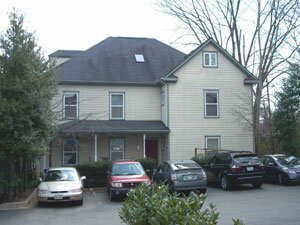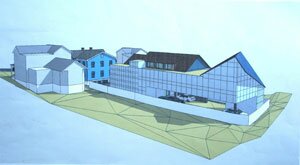220 South Street: Bad building or missed opportunity?

Down and out: Developer Oliver Kuttner is trying to save this South Street apartment building, but the Blue Moon Fund plans to demolish it to make room for a new conference center.
PHOTO BY DAVE MCNAIR
The Blue Moon Fund is getting ready to demolish a 13-year-old apartment building on its property at 222 South Street to make way for a new 6,800-square-foot conference center. But an adjoining property owner wonders why the philanthropic organization dedicated to "new economic, cultural, and environmental approaches to resource use, energy use, and urban development" didn't take him up on his proposal to save landfill space by simply letting him move the building next door. Oliver Kuttner says he verbally offered to buy the building for $40,000 and move it 60 feet west to his property.
Indeed, during the March 18 Board of Architectural Review meeting, at which the demo was approved, Mike Stoneking, architect for the project, said the Fund has "no interest in saving or relocating the building." In fact, mention of Kuttner's offer elicited chuckles from the audience, with someone joking that the Fund "would still have to look at it."
Responding to those concerns, Kuttner says he has offered to re-design the facade. "It's easy," he says, "to put a different face on a building."
However, Kristen Suokko, a vice president of the Fund, brushes aside such BAR meeting chuckles, saying it's not aesthetics motivating the Fund's decision to demolish the building, but principle.
"We're much more concerned about the building itself, which is highly inefficient," she says. "And with all due respect to the architect, not very well-built. We don't want to perpetuate that kind of construction."
However, according to Hook editor Hawes Spencer, who owned the structure from 2003 until 2006, while the building isn't an architectural award-winner, it was one of the first to use environmentally friendly Hardiplank siding and offered a view of mountains and passing trains from the back balconies.
"I thought it would be worth saving," Kuttner says. "They want to recycle the building and send the materials to Habitat for Humanity, but you can't recycle sheet rock, you can't recycle so many materials– the best way to recycle a building is to save it."
Indeed, that's becoming a trend in the green building movement, where preservation and conservation have merged. In a Hook story on green building last year, Michael Courts, a project manager with Artisan Construction, a company that specializes in green building and historic preservation, summed up the situation when he said, "You can't get much greener than saving an old house, which is essentially recycling something instead of throwing it away."
However, as Suokko explains, the Fund's new building on the South Street site will be LEED certified (a standard of energy efficiency from the U.S. Green Building Council), a model of green construction. In addition, she says the Fund plans to be one of Peter VanderLinde's first customers. (As previously reported, VanderLinde is opening a $10 million, 100,000-square-foot recycling center near Zion Crossroads in mid-May with a 270-foot state-of-the-art sorting machine.) Suokko says that 90 percent of the materials from the demo will be given to Habitat for Humanity or sent through VanderLinde's machine for reuse.
While the Blue Moon building is neither old nor historic– and therefore legally fair game for demolition– Kuttner still thinks it's a symbolic shame that a building with a willing buyer will be demolished. Kuttner also regrets that five apartments will be eliminated.
"We need these kind of reasonably priced apartments downtown," he says. "For us, it was an opportunity to have a low-cost building, and it would have provided affordable apartments downtown."
Spencer says that rents ranged from $850 to $1,050, among the lowest downtown for two-bedroom, two-bath apartments just one block from the thriving Downtown Mall.
"They allowed couples and roommates to live downtown without busting the bank," he says. In addition, Spencer says that tenants were usually allowed to park overnight in the front office building's parking spaces– making efficient use of a precious downtown resource.
Suokko seems unconvinced that prior uses offered as much public service as the Fund's new building, which will provide space to non-profit groups in Charlottesville, free of charge.
While Kuttner says he admires the work of the Blue Moon Fund, he thinks they need to "get off their high horse" with their criticism of the apartment building. As he points out, the new conference center's preliminary design appears to include a 24-foot-high windowless wall facing his property.
"That's what we'll have to look at: a big blank wall," he says. "I don't think that's a very nice thing to do."
Looking on the bright side, however, Kuttner jokes, "But I guess if someone wanted to sunbathe naked on our property, they could."

A preliminary design for the new Blue Moon Fund conference center, with a massive wall facing Oliver Kuttner's adjoining property
FILE PHOTO
#